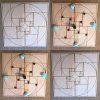My comments in bold below.
I can respect the effort. Feel free to show me companies working on this. I'd love to see a paper on a company rather than a college continuing and advancing this kind of work.
Needing candles is not the point, needing light and candles being inefficient and archaic is the point. Substitute earlier light bulbs as needed until the point makes sense.
I'm glad that advancements have been made in measuring acoustics.
My post was edited to include diffusion, but it duplicated and I removed it. Feel free to point me towards any companies building metasurface diffusion products or working on it.
To restate my problem: "Many [more expensive speakers] have issues that $100 computer speakers don't have."
No, I have not found even one speaker that meets my needs (sounds better in every audible and measurable way) with the above criteria and compared to a $250 DIY kit.
The LSR series is a nearfield monitor, and even midfield or further, I can hear the hiss with nothing plugged in (I put them in corners of my room, 6-8 feet away), and removing ground plugs or bringing speakers to a friend's studio with all balanced connections and power conditioning has not made a difference.
The Genelec 8260 has a waveguide and a coaxial driver, and when you limit the excursion of the midrange driver/make a three way speaker, the doppler effect doesn't affect the frequency response in any meaningful way as shown by measurements of that speaker. They also have a whitepaper showing the advancement of coaxial drivers and their flaws, which Genelec fixed. I consider the "ever changing waveguide" issue to be solved, just like the diffraction issue across air gaps and uneven surfaces.
I regularly use REW and a MiniDSP when I move my speakers, and want more absorption and even diffusion instead of reflections, and hopefully at some point can use a material that isn't unnecessarily thick and based on decades old designs.


